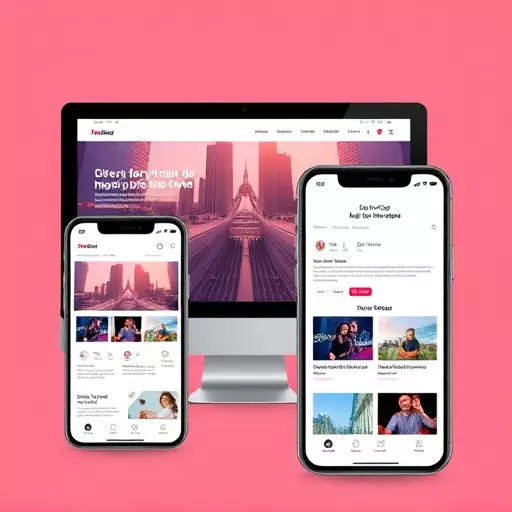Mobile-first responsive design in New Jersey leverages adaptive web design techniques, particularly fluid grid layouts and flexible images, to create dynamic, engaging experiences across diverse devices. These strategies ensure content optimization for smaller screens while maintaining visual appeal and performance. Parallax scrolling, implemented with CSS and JavaScript, adds depth and interactivity, enhancing user engagement without compromising integrity. By focusing on adaptability, businesses in New Jersey can deliver seamless experiences tailored to each user's device, staying competitive in today's digital landscape.
In the realm of mobile-first responsive design in New Jersey, understanding and implementing parallax scrolling can elevate user experiences dramatically. This visual depth trick not only enhances aesthetics but also improves website functionality across various devices. By adopting an adaptive web design approach, developers can ensure fluid grid layouts and flexible images that adapt seamlessly to different screen sizes. Explore best practices for integrating parallax effects smoothly, optimizing content presentation in both static and dynamic scenarios, and creating a visually captivating user experience tailored for modern mobile users.
- Understanding Parallax Scrolling: A Visual Depth Trick
- Mobile-First Approach: Optimizing for Smaller Screens
- Adaptive Web Design: Responsive to Every Device
- Fluid Grid Layouts: Creating a Dynamic Structure
- Flexible Images and Media: Fitting Content Without Distortion
- Best Practices: Implementing Parallax Effect Seamlessly
Understanding Parallax Scrolling: A Visual Depth Trick

Parallax scrolling is a visual trick that adds depth and dynamism to web designs, particularly in mobile-first responsive design approaches prevalent in New Jersey. This technique simulates a 3D effect by making background images move at different speeds than the foreground content as the user scrolls. It’s achieved through sophisticated CSS and JavaScript coding, allowing for seamless transition between layers of media. By combining fluid grid layouts and flexible images, web designers can ensure that these effects adapt gracefully across various devices and screen sizes, aligning with the principles of adaptive web design.
In the context of New Jersey’s mobile-first responsive design trends, understanding parallax scrolling is crucial. It allows designers to create visually appealing, engaging experiences for users on smartphones and tablets without sacrificing performance or content integrity. Adaptive web design emphasizes fluid grid layouts and flexible media, ensuring that parallax effects remain smooth and effective regardless of the device being used. This approach not only enhances user engagement but also reflects contemporary design trends in the vibrant digital landscape.
Mobile-First Approach: Optimizing for Smaller Screens

In modern web development, the mobile-first approach has become a cornerstone of responsive design, especially in New Jersey where a significant portion of internet users access websites through smaller screens. This strategy prioritizes optimizing content and layout for smartphones and tablets before scaling up for larger displays. Adaptive web design, facilitated by fluid grid layouts, ensures that designs seamlessly adjust to different screen sizes, providing an optimal user experience regardless of device.
Implementing flexible images and media is another crucial aspect of this approach. By utilizing CSS properties like `max-width: 100%;`, developers can ensure media elements scale down proportionally on smaller screens, preventing clunky layouts and long loading times. This adaptability not only improves the user interface but also enhances website performance, making it a key component in creating successful, mobile-first responsive designs.
Adaptive Web Design: Responsive to Every Device

In today’s digital landscape, where users access websites from a plethora of devices, from desktops to tablets and smartphones, Adaptive Web Design has become a cornerstone of successful online presence, especially for businesses in New Jersey looking to cater to a mobile-first audience. This approach ensures that web content is optimized and presented seamlessly across various screen sizes and resolutions. By employing fluid grid layouts, designers create structures that adapt dynamically, ensuring every pixel is utilized efficiently without sacrificing user experience.
One of the key elements of adaptive web design is the use of flexible images and media. Responsive images adjust their size based on the device’s display, preventing overly stretched or compressed visuals. This, coupled with fluid grid systems, results in a website that offers a consistent, positive experience no matter the screen size. For businesses in New Jersey aiming to enhance their online visibility, adopting mobile-first responsive design strategies is essential for staying competitive and engaging with customers across all digital touchpoints.
Fluid Grid Layouts: Creating a Dynamic Structure

In the realm of mobile-first responsive design in New Jersey, fluid grid layouts have emerged as a powerful tool for creating adaptive web designs that seamlessly cater to various screen sizes and orientations. Unlike traditional fixed-width layouts, fluid grids utilize percentages instead of pixels, enabling a dynamic structure that adapts gracefully across devices, from desktops to tablets to smartphones. This approach ensures that both the content and design maintain their integrity and visual appeal regardless of the user’s device, enhancing the overall user experience.
By employing flexible images and media, fluid grid layouts allow for creative and responsive design solutions. Elements can adjust their size and positioning based on available space, ensuring critical information remains visible and accessible. This adaptability is especially crucial in today’s diverse digital landscape where users often access websites on a range of screens with varying capabilities. Adaptive web design powered by fluid grid layouts not only meets these challenges but also offers opportunities for innovative presentation and interaction strategies, setting the stage for engaging and accessible online experiences for all users.
Flexible Images and Media: Fitting Content Without Distortion

In the realm of mobile-first responsive design in New Jersey, adaptive web design plays a pivotal role in ensuring that digital experiences are seamless and visually appealing across various devices. One key aspect of this is the use of fluid grid layouts, which allow for dynamic content arrangement based on screen size. This means that as a user transitions from a desktop to a mobile device, the layout adapts gracefully, maintaining visual harmony without sacrificing usability.
Flexible images and media are another integral part of this process. By employing responsive image techniques, such as setting width in percentages rather than fixed pixels, content remains sharp and distortion-free on different screens. This adaptability is crucial for engaging users on both larger displays and smaller mobile phones, ensuring that every user has an optimal viewing experience tailored to their device, be it a bustling smartphone screen or a calm tablet interface.
Best Practices: Implementing Parallax Effect Seamlessly

When implementing the parallax scrolling effect in responsive design, especially for mobile-first strategies in New Jersey, it’s crucial to embrace best practices that ensure a seamless user experience across various screen sizes and devices. Start by adopting adaptive web design principles, utilizing fluid grid layouts that adapt gracefully to different viewport dimensions. This ensures your parallax elements remain visually appealing and functional on both desktop and mobile platforms.
Focus on flexible images and media, employing techniques like lazy loading and responsive image formats to optimize performance. These strategies prevent jarring visual shifts or lag when users scroll, enhancing the overall fluidity of the design. Additionally, pay meticulous attention to touch interactions, ensuring that gestures like swiping and pinching interact naturally with the parallax effect, creating a cohesive experience for all users regardless of device type.


